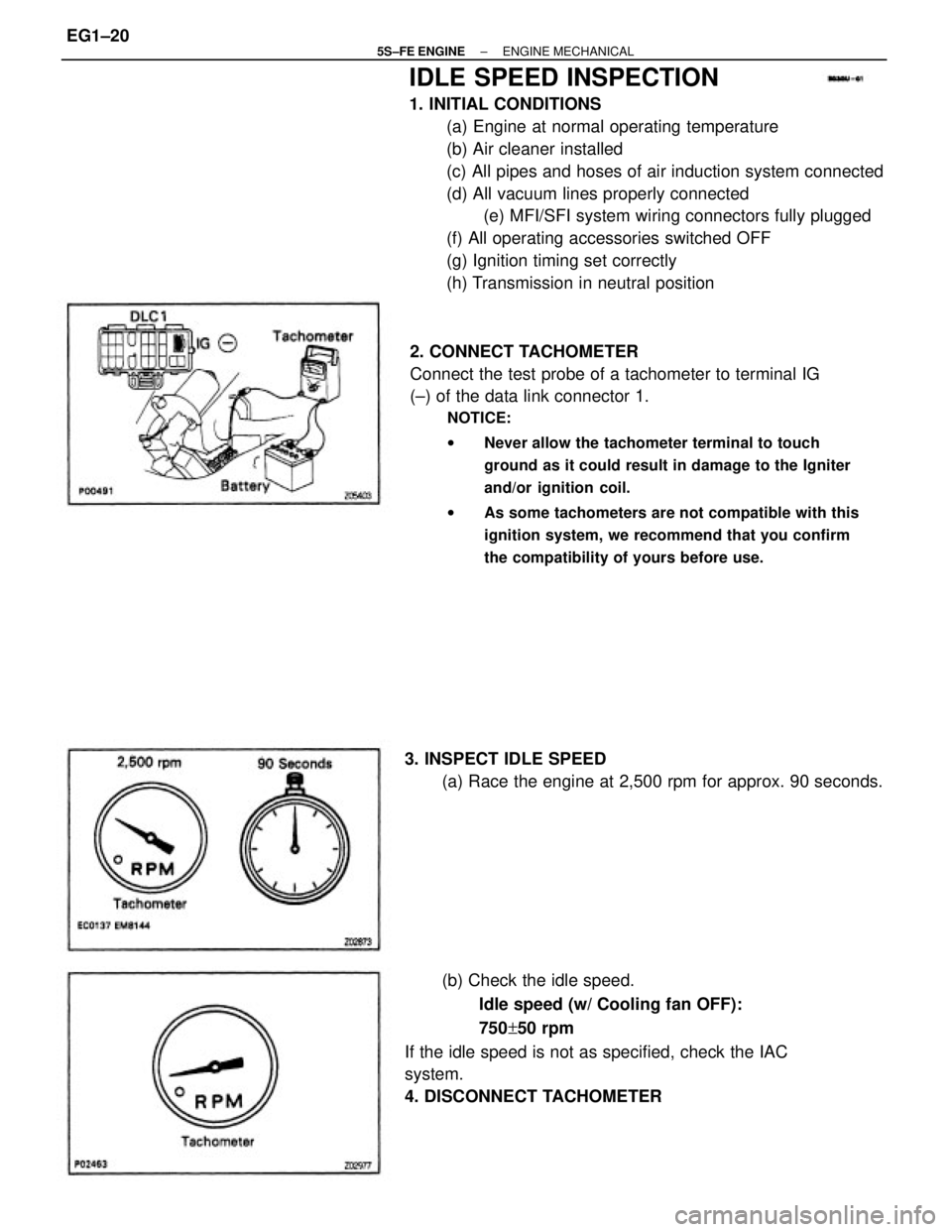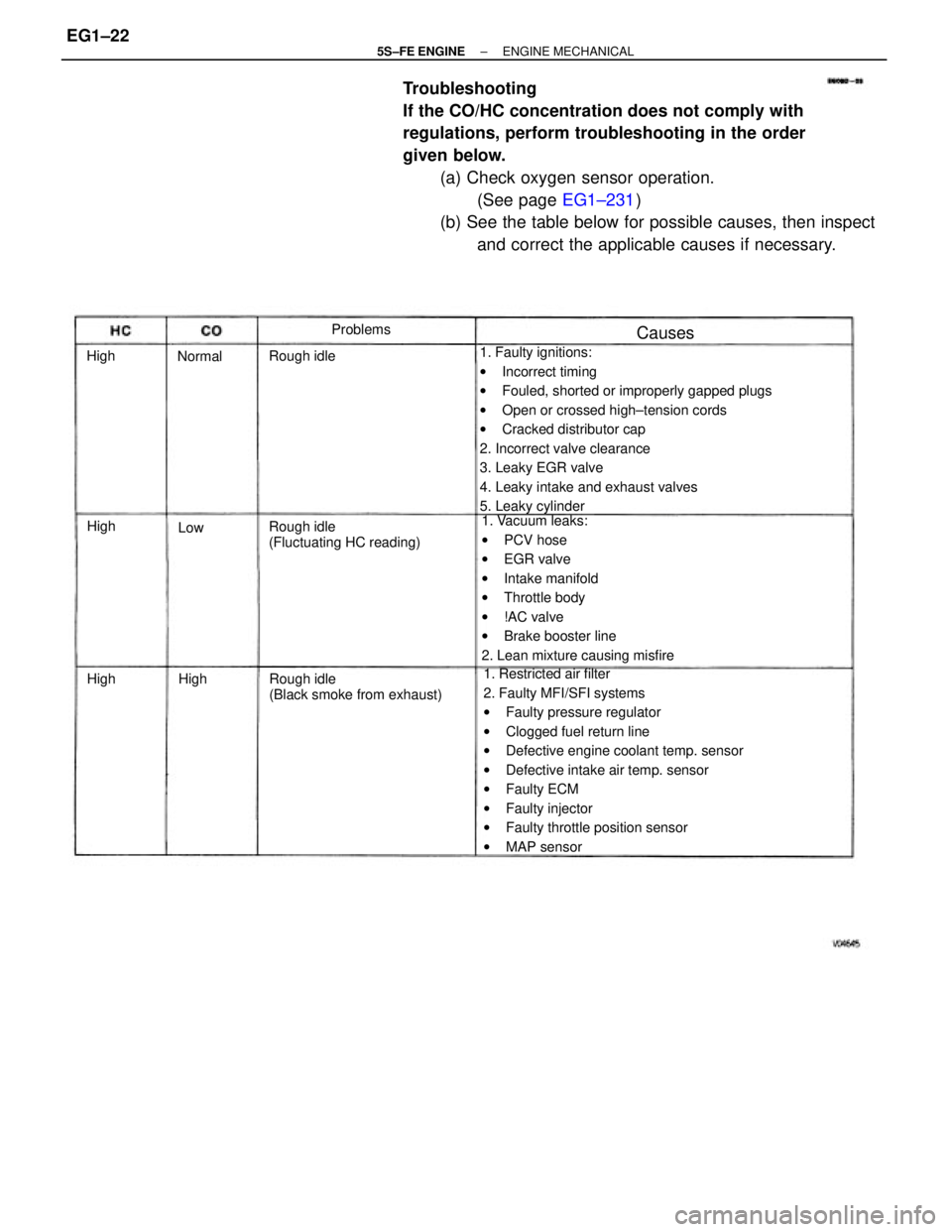Page 56 of 4770
Plug for vacuum hose, fuel hose
etc.
Battery specific gravity gauge09256±00030 Hose Plug Set
09904±00010 Expander Set
Piston ring compressorEngine tune±up tester Connecting rod aligner
Precision straight edge
EQUIPMENT
Piston ring expander Compression gauge
Magnetic finger Cylinder gauge
Torque wrenchDye penetrant CO/HC meterCaliper gauge
Spring tester
ThermometerDial indicator
Steel squareMicrometer
Valve spring
Valve spring Plastigage
Soft brushHeater
± 5S±FE ENGINEENGINE MECHANICALEG1±6
Page 70 of 4770

IDLE SPEED INSPECTION
1. INITIAL CONDITIONS
(a) Engine at normal operating temperature
(b) Air cleaner installed
(c) All pipes and hoses of air induction system connected
(d) All vacuum lines properly connected
(e) MFI/SFI system wiring connectors fully plugged
(f) All operating accessories switched OFF
(g) Ignition timing set correctly
(h) Transmission in neutral position
2. CONNECT TACHOMETER
Connect the test probe of a tachometer to terminal IG
(±) of the data link connector 1.
NOTICE:
wNever allow the tachometer terminal to touch
ground as it could result in damage to the Igniter
and/or ignition coil.
wAs some tachometers are not compatible with this
ignition system, we recommend that you confirm
the compatibility of yours before use.
(b) Check the idle speed.
Idle speed (w/ Cooling fan OFF):
750+50 rpm
If the idle speed is not as specified, check the IAC
system.
4. DISCONNECT TACHOMETER 3. INSPECT IDLE SPEED
(a) Race the engine at 2,500 rpm for approx. 90 seconds.
± 5S±FE ENGINEENGINE MECHANICALEG1±20
Page 71 of 4770

IDLE AND OR 2,500 RPM CO/HC
CHECK
HINT: This check is used only to determine whether or
not the idle CO/HC complies with regulations.
1. INITIAL CONDITIONS
(a) Engine at normal operating temperature
(b) Air cleaner installed
(c) All pipes and hoses of air induction system connected
(d) All accessories switched OFF
(e) All vacuum lines properly connected
HINT: All vacuum hoses for EGR systems, etc. should
be properly connected.
(f) MFI/SFI system wiring connectors fully plugged
(g) Ignition timing set correctly
(h) Transmission in neutral position
(i) Tachometer and CO/HC meter calibrated by hand.
4. INSERT CO/HC METER TESTING PROBE AT LEAST
40 cm (1.3 ft) INTO TAILPIPE DURING IDLING
5. IMMEDIATTELY CHECK CO/HC CONCENTRATION
AT IDLE AND/OR 2,500 RPM
Complete the measuring within 3 minutes.
HINT: When performing the 2 mode (2,500 rpm and
idle) test, follow the measurement order prescribed by
the applicable local regulations. 2. START ENGINE
3. RACE ENGINE AT 2,500 RPM FOR APPROX. 180
SECONDS
± 5S±FE ENGINEENGINE MECHANICALEG1±21
Page 72 of 4770

Troubleshooting
If the CO/HC concentration does not comply with
regulations, perform troubleshooting in the order
given below.
(a) Check oxygen sensor operation.
(See page EG1±231)
(b) See the table below for possible causes, then inspect
and correct the applicable causes if necessary.
1. Faulty ignitions:
wIncorrect timing
wFouled, shorted or improperly gapped plugs
wOpen or crossed high±tension cords
wCracked distributor cap
2. Incorrect valve clearance
3. Leaky EGR valve
4. Leaky intake and exhaust valves
5. Leaky cylinder
1. Restricted air filter
2. Faulty MFI/SFI systems
wFaulty pressure regulator
wClogged fuel return line
wDefective engine coolant temp. sensor
wDefective intake air temp. sensor
wFaulty ECM
wFaulty injector
wFaulty throttle position sensor
wMAP sensor 1. Vacuum leaks:
wPCV hose
wEGR valve
wIntake manifold
wThrottle body
w!AC valve
wBrake booster line
2. Lean mixture causing misfire
Rough idle
(Black smoke from exhaust) Rough idle
(Fluctuating HC reading) Rough idleProblems
Causes
Normal
High High High
HighLow
± 5S±FE ENGINEENGINE MECHANICALEG1±22
Page 94 of 4770
11. DISCONNECT OIL PRESSURE SWITCH
CONNECTOR
12. DISCONNECT ENGINE WIRE (FOR OXYGEN
SENSORS) FROM ENGINE HANGER
13. REMOVE WATER OUTLET
(a) Disconnect the following connectors:
(1) Engine coolant temperature sender gauge con±
nector
(2) Engine coolant temperature sensor connector
(b) Disconnect the following hoses:
(1) Upper radiator hose
(2) Water bypass pipe hose
(3) Heater water hose
(4) IAC water bypass hose
(5) 2 TVV (for EVAP) vacuum hoses
14. REMOVE WATER BYPASS PIPE
(a) Disconnect the following hoses:
(1) IAC water bypass hose
(2) Heater water hose
(3) w/ Oil Cooler:
2 oil cooler water bypass hoses (5) 3 bolts and 2 nuts
(6) Exhaust manifold
(7) Gasket
(8) Retainer
(9) Cushion
(10) WU±TWC
(c) Remove the 2 bolts, water outlet and gasket.
± 5S±FE ENGINEENGINE MECHANICALEG1±44
Page 95 of 4770
(f) Disconnect the following hoses from the throttle
body, and remove the throttle body.
(1) Water bypass hose from water outlet
(2) Water bypass hose from water bypass pipe
(3) California:
Air hose from cylinder head
Except California:
Air hose from air tube (c) Disconnect the following hoses from the throttle
body.
(1) PCV hose
(2) 2 vacuum hoses from EGR vacuum modulator
(3) Vacuum hose from TVV (for EVAP) (b) Remove the 2 bolts, 2 nuts, water bypass pipe and
gasket.
(c) Remove the O±ring from the water bypass hose.
15. REMOVE THROTTLE BODY
(a) Disconnect the throttle position sensor connector.
(b) Disconnect the IAC valve connector.
(d) Type A:
Remove the 4 bolts.
(e) Type B:
Remove the 2 bolts and 2 nuts.
± 5S±FE ENGINEENGINE MECHANICALEG1±45
Page 96 of 4770
17. DISCONNECT VACUUM HOSES
Disconnect the following hoses:
(1) MAP sensor hose from air intake chamber
(2) Brake booster vacuum hose from air intake cha±
mber
(3) PS vacuum hose from air intake chamber
(4) Vacuum sensing hose from fuel pressure regula±
tor 1
S. W/ A/C:
DISCONNECT A/C IDLE±UP VALVE CONNECTOR
19. EXCEPT CALIFORNIA:
REMOVE AIR TUBE
(a) Disconnect the following hoses from the air tube:
(1) w/ A/C:
Air hose from ASV
(2) 2 air hoses from PS pump I6. REMOVE EGR VALVE AND VACUUM MODULATOR
(a) Disconnect the EGR gas temperature sensor connec±
tor.
(b) Disconnect the following hoses:
(1) 2 vacuum hoses from VSV (for EGR)
(2) Vacuum hose from charcoal canister
(c) Disconnect the vacuum hose clamp.
(d) Loosen the union nut of the EGR pipe, and remove the
2 nuts, EGR valve, vacuum modulator, vacuum hoses
assembly and gasket.
(b) Remove the 3 bolts, wire clamp and air tube.
± 5S±FE ENGINEENGINE MECHANICALEG1±46
Page 97 of 4770
20. CALIFORNIA:
REMOVE AIR TUBE
(a) Disconnect the following hoses:
(1) w/ A/C:
A/C hose (from ASV) from air tube
(2) 2 air hoses (from PS pump) from air tube
(3) California only:
2 vacuum hoses from VSV (for fuel pressure
control)
(4) Vacuum hose from air intake chamber
(b) Remove the 3 bolts, wire clamp and air tube.
21. DISCONNECT 2 ENGINE WIRE GROUND STRAPS
FROM INTAKE MANIFOLD
22. DISCONNECT KNOCK SENSOR AND VSV (FOR
EGR) CONNECTORS
23. CALIFORNIA ONLY:
DISCONNECT VSV (FOR FUEL PRESSURE CON±
TROL) CONNECTOR
24. REMOVE VSV OR VSV ASSEMBLY
25. REMOVE INTAKE MANIFOLD
(a) Remove the 4 bolts, wire bracket, No.1 air intake
chamber and manifold stays.
(b) Remove the bolt, vacuum hose bracket, and discon±
nect the engine wire.
(c) Remove the6 bolts, 2 nuts, intake manifold and
gasket.
± 5S±FE ENGINEENGINE MECHANICALEG1±47